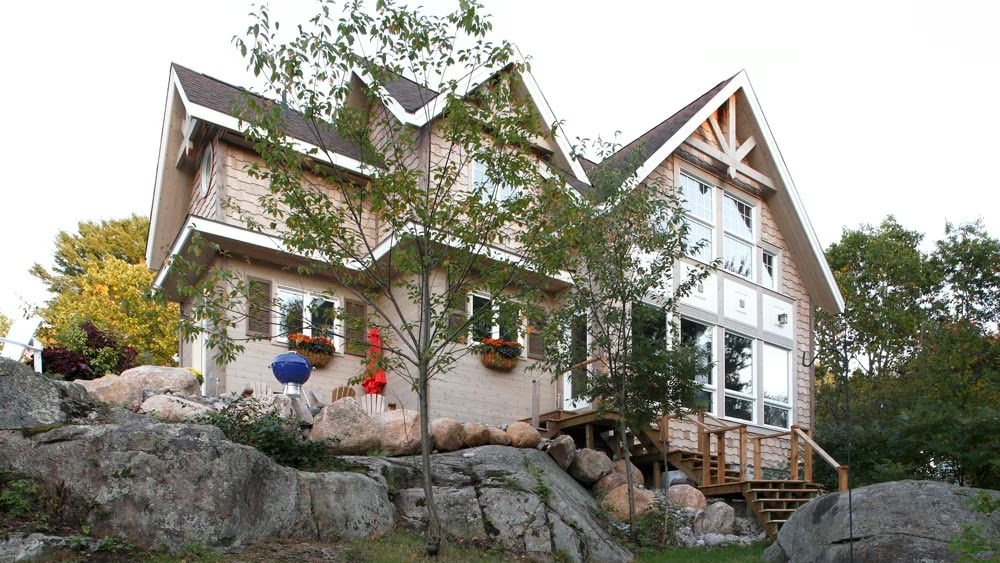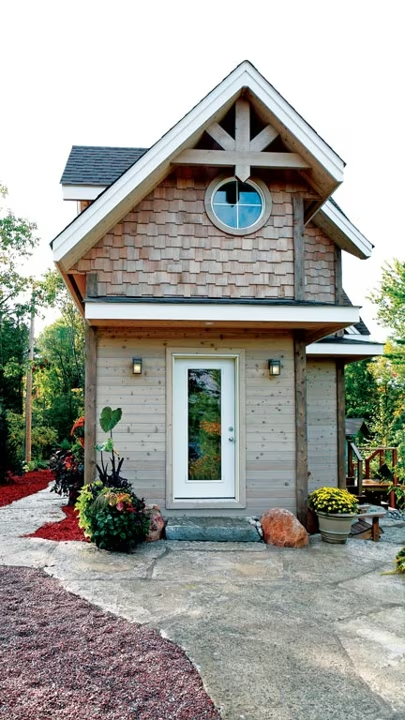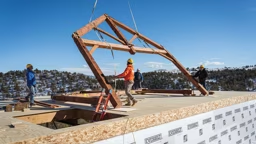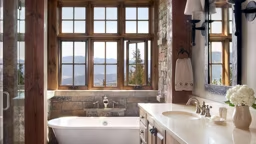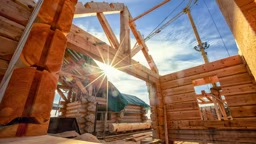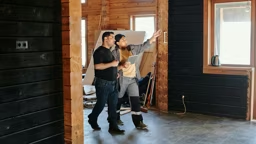Buildable land is at a premium. As costs increase in desirable locations, such as golf resorts, lakes and mountain towns, single-family home density increases, causing lot widths to decrease. Even rural areas can be prone to thinner, tapered lots due to the topography of the location.
“Around our area, we see narrow lots frequently,” says Remington Brown, design manager at StoneMill Log & Timber Homes in Knoxville, Tennessee. “Typically they are lake or mountainside lots.”
While a narrow lot can save on land costs, it can be challenging to situate a home’s footprint on it. Fortunately, log and timber home designers have proven strategies to make the most of slender sites.
“A few common design issues include parking and/or garage placement, privacy, ample daylighting and outdoor living areas,” according to Matt Franklin, lead architect at M.T.N Design in Meridian, Idaho. “With narrow lots, the sides are typically closer to the neighbors, and that tends to push the design toward the front and back of the lot.”
With many clients seeking front-loading, three-car garages, the challenge is to design a home that minimizes the garage on the front facade, Matt says. To achieve that, he suggests offsetting bays or recessing a smaller garage next to a double garage for storing recreational vehicles like snowmobiles or motorcycles.
The other challenge is to make the front doorway pop by adding a covered entry with a timber frame truss overhead. “That way it’s absolutely clear where visitors should enter,” explains Matt.
Ensure Adequate Natural Light
Because the neighbors can be close, narrow-lot designs tend to concentrate window placement on the front and back of the home, Matt shares. If you opt for side windows for cross illumination, glass block or one-way window film can ensure privacy.
Another option is to add a monitor to the roof system with clerestory windows. Popular in 19th century railroad cars and traditional sugar houses (a building used to boil sap into maple syrup), it’s a raised structure running along the ridge of a double-pitched roof that runs parallel with the main roof system. It can provide abundant daylight without glare, as well as vent hot air in summer. “Skylights are an option, too, though we don’t see a lot of those anymore,” Matt admits.
Think Through Interior Layout
When Matt designs a narrow home, he typically places the great room, kitchen and dining area in an open configuration toward the rear, using the space at the front for an office or additional bedroom near the entry. “If you push the public spaces toward the back of the home, you can use the space behind the garages for more utilitarian needs, such as a mudroom, pantry or a guest bath,” he suggests.
In a narrow footprint, it doesn’t take long to run out of space. That means either going up with a second story, down into a basement or both. “If your site permits a basement, it’s cheap square footage that can effectively double your living area,” Remington says. “It’s a great space for spare bedrooms, rec rooms and all your mechanicals. In the unlikely event we’re working with a narrow lot without a slope, then we encourage people to go up with a second story.”
Matt agrees: “Even though many of today’s buyers want a master suite on the main level, sometimes you have to push that space to the second floor,” he says.
Know Your Dimensions
Most log and timber frame companies offer floor plans designed to accommodate a wide range of property types, so it helps to know the size and shape of your site before you start exploring plans. As you begin your research, pay close attention to each plan’s dimensions.
“We’ve had plenty of people fall in love with a floor plan, only to find it won’t fit on their lot,” Remington acknowledges, “but there are solutions. We had a client in Colorado who had to cut an entire wing off the plan and reposition the rooms in the basement. They loved the plan so much that they weren’t willing to compromise, so we got resourceful to meet their needs.”
Elements That Have a Major Impact on Costs
Don Downs, southeast regional project manager at Woodhouse: The Timber Frame Company in Mansfield, Pennsylvania, and a classically trained handcrafter with 30 years of construction experience, says that at home shows, their booth displays large photos of two similarly sized kitchens.
“One kitchen cost $19,000, the other, $90,000,” Don recalls. “Custom cabinetry, high-end appliances and granite countertops can take a large bite out of your budget.”
It’s fairly common knowledge that the kitchen is the most expensive space in a new home, followed by baths. But other areas can dramatically affect costs as well. A steep and complicated roof system, with multiple hips and valleys, is architecturally pleasing and can add curb appeal, but it’s also pricey. A full masonry fireplace can top $100k in costs, which is why they’re so rarely specified.
“We typically refer to them as fixed costs versus variable costs, and there’s always a degree of push-pull when developing a budget,” explains Laura Jamison, marketing manager for PrecisionCraft Log & Timber Homes and Riverbend Timber Framing. “Your fixed costs are the things you can’t control, such as what your wind and snow-load engineering requirements will be or how much it will cost to put a road or driveway into the site and install infrastructure, including water and electricity.
“The variable costs you can control,” Laura continues. “That’s the size and design of the home and its architectural complexity. Plus, there are material choices that are pretty unique to the log and timber world, such as what species a client selects. If it’s a timber frame, do they want simple king post trusses in the great room or do they want an arched timber frame barrel design? Those are two very different costs. All of these choices are made in the design stage. I tend to recommend they spend on the high-touch, use-everyday features of their new home.”
Remington Brown, StoneMill Log & Timber Homes’ design manager agrees: “All of the interior finishes have an enormous impact. Flooring, especially, is a big one. That beautiful hand-scraped, reclaimed hardwood may be pretty, but it also costs $15 per square foot. An engineered-wood product, in contrast, can cost as little as $4 per square foot. Stretch that out over a couple thousand square feet and you can see the impact.”
Remington also warns clients that site improvement costs can easily go over budget, thanks to the unknowns during excavation, landscaping or well drilling, so he advises a 10 percent safety net. “That portion should always have a contingency built-in for when — not if — you run into issues during site prep.”




